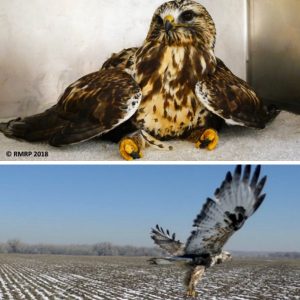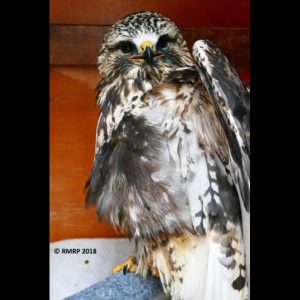
 This story was shared with us by Rocky Mountain Raptor Program in Colorado.
This story was shared with us by Rocky Mountain Raptor Program in Colorado.
The first day of the year brought the rehabilitation staff at the Rocky Mountain Raptor Program an adult, rough-legged hawk in desperate need of assistance. It had been found by good Samaritans in Gill, Colorado. Not only had the hawk’s feathers been lightly singed by a methane flare but, more critically, the hawk was underweight (800 grams; a little more than 1.5 pounds) and unable to stand or use its feet.
The limited leg use was a red flag to rehabilitation staff who immediately tested the hawk’s blood for lead. Sure enough, the hawk had an extremely high lead level at 1.2 ppm. Staff immediately started chelation treatment to remove the lead from the hawk’s blood, but lead poisoning has another insidious effect in raptors — it slows down and even prevents a raptor from digesting food.
To combat the nutrition problem, rehabilitation staff tube-fed EmerAid Intensive Care Carnivore diet to overcome the effects of GI stasis. Treatment was incredibly slow, but with perseverance and time the hawk regained use of its legs and gained the weight it had lost.
After a lengthy stay, the brave hawk gained 319 grams (about 11 ounces) and was released back to its wintering grounds, ready for its long migration back up to the Arctic at a much healthier weight of 1,119 grams (almost 2.5 pounds).

